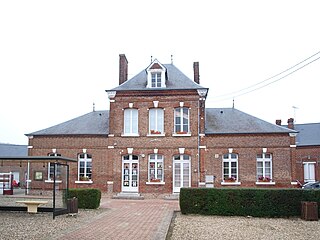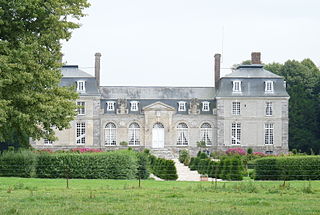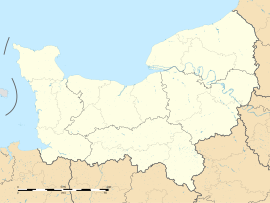
Seine-Maritime is a department of France in the Normandy region of northern France. It is situated on the northern coast of France, at the mouth of the Seine, and includes the cities of Rouen and Le Havre. Until 1955 it was named Seine-Inférieure. It had a population of 1,255,633 in 2019.
Le Tréport is a commune in the Seine-Maritime department in Normandy, France.

The arrondissement of Dieppe is an arrondissement of France in the Seine-Maritime department in the Normandy région. It has 343 communes. Its population is 237,203 (2016), and its area is 3,120.3 km2 (1,204.8 sq mi).

Mers-les-Bains is a commune in the Somme department in Hauts-de-France in northern France.

Ingouville, also known as Ingouville-sur-Mer, is a commune in the Seine-Maritime department in the Normandy region in northern France.

Saint-Aubin-sur-Mer is a commune in the Seine-Maritime department in the Normandy region in northern France.

Vieux-Rouen-sur-Bresle is a French commune in the Seine-Maritime department in the Normandy region in northern France.

Veules-les-Roses is a commune in the Seine-Maritime department in the Normandy region in northern France.

Hautot-sur-Mer is a commune in the Seine-Maritime department in the Normandy region in northern France.

Varengeville-sur-Mer is a commune in the Seine-Maritime department in the Normandy region in north-western France.

Sainte-Marguerite-sur-Mer is a commune in the Seine-Maritime department in the Normandy region in northern France.

Veulettes-sur-Mer is a commune in the Seine-Maritime department in the Normandy region in northern France.

Sotteville-sur-Mer is a commune in the Seine-Maritime department in the Normandy region in north-western France.

Saint-Sylvain is a commune in the Seine-Maritime department in the Normandy region in northern France.

The GR21 is a long-distance hiking trail in Normandy, France. It is part of the GR network of trails. It begins at the port city of Le Havre, a Unesco World Heritage Site, climbs through parkland to Montivilliers, then follows the chalk cliffs of the Pays de Caux for most of the route. Étretat is known for its chalk formations, painted by Claude Monet and other artists. It passes through various seaside resorts and fishing villages, including the port of Dieppe and finishes at the resort of Le Tréport, close to the historic town of Eu. The whole route is within the Seine-Maritime département.
The Canton of Eu is a canton situated in the Seine-Maritime département and in the Normandy region of northern France.

The Yères is a river of Normandy, France, 40 kilometres (25 mi) in length, flowing through the department of Seine-Maritime.
The Communauté de communes d'Yères et Plateaux was located in the Seine-Maritime département of the Normandy region of northern France. It was created in January 2003. It was dissolved in January 2017.
The Communauté de communes des Villes Sœurs is a Communauté de communes located in both the Seine-Maritime department and the Somme department of north-western France. On 1 January 2017 it was expanded with 7 communes, and renamed Communauté de communes des Villes Sœurs. Its seat is Eu. Its area is 214.8 km2, and its population was 36,979 in 2018, of which 6,771 in Eu and 4,723 in Le Tréport.

The Gare d'Eu is a railway station in the commune of Eu in the Seine-Maritime department, France, in Normandy.






















